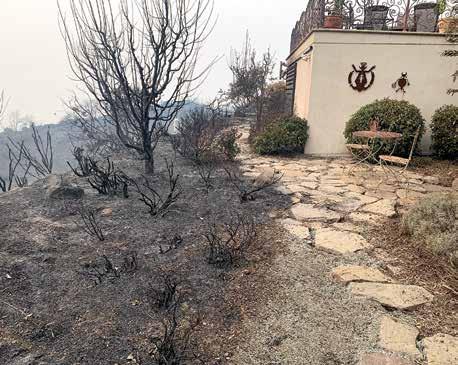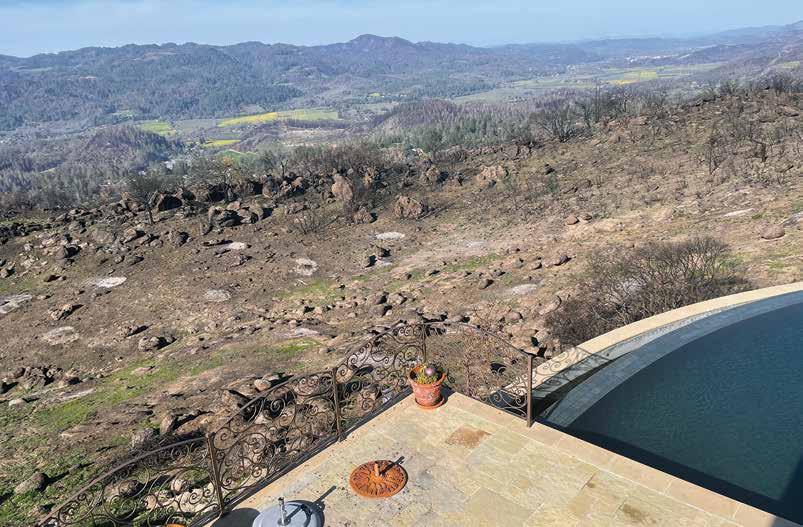
7 minute read
Lodi
In Memoriam Bob Hartzell (1934-2020)
Robert Pollock Hartzell (86) passed away peacefully at home surrounded by his loved ones on November 21, 2020.
Born April 16, 1934 in San Rafael, California, Bob began his university studies at UC Berkley. He was one of the original “Twinkling Tubas” in the Cal Marching Band. Bob transferred to UC Davis graduating with a B.S. in Plant Sciences. He was a brother in the fraternity of Sigma Alpha Epsilon. Following a stint in the U.S. Army, Bob worked as an agronomist for Tillie Lewis Foods in Stockton where he helped to introduce Roma tomatoes to the U.S. market as well as moving tomato harvesting from hand-picked to a mechanized harvest.
Under Governor Ronald Reagan, he served as Deputy Director of the Department of Food and Agriculture for the state of California. Following that post, Bob worked with the Iran-California Farming Company to develop desert lands for growing crops for the European market, and in Indonesia developing palm oil production. Bringing his professional life back to U.S. soil, he was co-owner of the Murphy’s Historic Hotel in the foothills of California where he led the restoration efforts for the historic property. For 18 years, Bob served as Executive Director of the California Association of Wine Grape Growers (CAWG) working tirelessly to promote the wines of California receiving recognition from the United States House of Representatives for his contributions to the wine industry.
One of Bob’s personal passions was music, and he was an accomplished pianist and organist. In addition to these instruments, he also played the bass fiddle in the Stockton Symphony Orchestra. He was instrumental in the restoration and installation of the theater pipe organ in the Bob Hope Theater in Stockton as well as the theater pipe organ at Ironstone Vineyards. Bob fulfilled his dream of combining agriculture, wine, and pipe organ music when he purchased the 2/11 Robert Morton Theater Pipe Organ that was originally installed in San Francisco’s Castro Theatre in 1987, followed by the vineyard property on which he built the complex which would house the organ. The culmination of this dream was co-founding Harmony Wynelands with his wife Linda. He loved to entertain family, friends, and visitors by playing requests on the pipe organ.
Just a few of Bob’s significant professional and personal distinctions are The Award of Distinction from the College of Agricultural and Environmental Science at UC Davis (1998), the Stockton Arts Commission Service Award (2013), the Fox Bob Hope Theatre Meritorious Service Award (2006), and Lodi District Chamber of Commerce Agribusiness Person of the Year (1997). His great love of his community led to serving on many boards and committees including The San Joaquin Historical Society, The Brotherhood of the Knights of the Vine (Founding Member-Lodi Chapter), Rotary International, and the Order of the Masons.
During Bob’s long, successful, and ever-changing career, Bob served as the Executive Director of the California Association of Wine Grape Growers promoting the wines of California for 18 years. For this work, he was recognized by the United States House of Representatives. He and his wife, Master Lady Linda Hartzell, co-founded Harmony Wynelands where wonderful wines are made in a beautiful country-estate setting.
The Lodi Chapter of the Knights of the Vine has held numerous events at Harmony Wynelands. One of my favorite memories of Bob is listening to him play the restored 2/11 Robert Morton Theater Pipe Organ that was originally installed in San Francisco’s Castro Theatre. This impromptu performance by Bob took place before a Silent Movie Night at Harmony where the original Phantom of the Opera was shown.
Thank you, Bob. It has truly been an honor.
- Ken Levy, Master Commander
Knights of the Vine, Lodi Chapter
Lodi Lodi
Napa Valley Fires:
A Personal View By Pat Pingitore
Napa Valley is generally thought of as Paradise to those of us who live here and the millions that come to visit. But 2020 in Napa Valley can only be described as a year from Hell.
Not only did Covid-19 impact the agricultural workers to a high degree (>50% of infections are in the Latino community), but tasting room closures and the tourism industry were reduced to a fraction of normal; impacting wine sales to a significant degree. Any of us on winery website mailing lists have been receiving plenty of good offers with 20-30% off stellar wines. Then came August and September!
The Valley was subjected to record heat on two occasions before a tropical storm in August (unheard of in Northern California) produced lightning strikes that sparked 2 of the 3 largest wild fires in California’s history. This included the LNU complex fire, mainly in Napa County, which burned over 350,000 acres and started the air quality concerns that lingered for weeks. The fires were so large that tens of thousands of residents were forced to evacuate out of an abundance of caution (including yours truly). A month later, the Glass Fire ignited causing extremely dangerous conditions and burned for more than a week with 67,000 acres scorched; that includes areas familiar to many of you such as the AVAs of St. Helena, Spring Mountain, Howell Mountain and Calistoga. About 200 homes were destroyed, including six on the street where we live: one was only 100 yards from our door. I am including a picture of our view as we evacuated for a second time in two months. Fortunately, we escaped with minor damage to outdoor structures, landscape and furniture. Others were not so lucky.
At least 30 wineries (and restaurants) were completely lost or damaged such as Chateaux Boswell, Behrens on Spring Mountain, Burgess Cellars in Deer Park, Cain Vineyard, Castello di Amorosa, Dutch Henry Winery, Fairwinds Estate, Fantesca Estate, Merus, Newton Vineyard, Paloma, Sherwin Family, Sterling and Tofanelli, among others.
Portions of the Meadowood Resort and the famed Michelin 3 star restaurant there were also destroyed.
The cause is under investigation, but an electric fence, arson or the under carriage of a vehicle are being considered as possible sparks in an extreme fire danger period (hot dry weather and strong winds).
This has, of course, seriously impacted the 2020 harvest season. Any up-valley Cabernet Sauvignon that was still on the vine will undoubtedly be considered useless. Some wineries actually paid workers NOT TO PICK!
Although much of the up-valley Sauvignon Blanc and other white varietals were already in fermentation tanks, most of the Cabernet, Syrah and Merlot remained on the vines awaiting final ripening. The dilemma that faced vintners was the issue of smoke taint for this season - pick early or not at all. There has been smoke in the air since August!

continued >>>


As you may know, smoke taint is caused by exposure of the grapes to volatile phenols such as guaiacol and 4-methylguiacol. The compounds permeate the waxy cuticle of grape skins and bind to the sugars forming glycosides. This makes them undetectable to taste or smell until fermentation begins, releasing the phenols and their smoky notes. The smoky notes may not be released until tasted and exposed to mouth acids.
The white varietals had mostly been picked by the time of the first fire and typically don’t spend a lot of time with grape skin contact so they and Rosés may be okay. However, the red varietals were exposed to the initial smoke during verasion (a sensitive time) and then again before complete ripening.
As a result many vintners either picked earlier than they normally would (brix 20-23) and/or resorted to “microferments” to actually test the batches. Others had stockpiled wine from previous years to use in blending. Some may use slightly tainted wine to blend with other sourced fruit as bulk wine. As one vintner put it, “it is abundantly clear that wineries continued to walk a fine line between exposure to the elements and the hang time needed for ripening”. But we need not be apocalyptic. There will be wine made from California and the Napa Valley this year and the great majority of those will be free from smoke taint. However, there will be less wine made (especially red) and this will need intervention by various methods including reverse osmosis which may strip out the character of the wines.
2020 Napa (and to a lesser degree Sonoma) may not be the best vintage of our lives. Fortunately there are plenty of wonderful wines available already in the bottle for you to consider.
All in all, we are grateful our home was spared and that we are safe. We feel for our neighbors and know many want to know how they can help. One very important thing is to support the wineries here. To help out the wineries affected, peruse those I listed above and visit their websites to see what you might favor. Your support will definitely help in their recovery.


